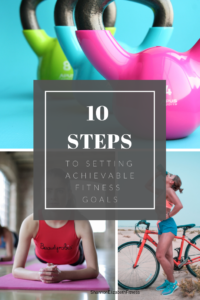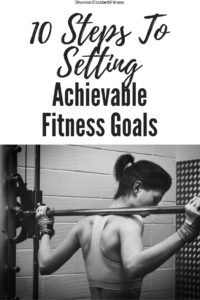Post contains affiliate links. See Disclosure for details. Opinions are my own
Setting fitness goals can be a challenge if you’ve never done it successfully before.
Weight-loss, regardless of how much you have to lose, takes hard work, patience, and dedication. Which is something that is easy to say but much more difficult to do. Because even with the best of intentions, without a concrete plan, reaching weight-loss and/or fitness goals can be extremely difficult. Or most likely, impossible. Think about it. How many times have you heard of someone reaching a fitness or weight-loss goal without a plan in place?

Most people set a number in their head that they want to achieve and then…that’s it. A lot of people don’t go much further. Some will say they will work out or eat less but then not define what that really entails. Like many things in life, success is in the details!
Realistic goals = attainable goals.
Before I get into actual goal setting, first a word on realistic goals. Before you start to put a plan into place, make sure the goal(s) you have chosen for yourself are realistic. For example, it may not be reasonable to set a goal of losing 100 lbs in one year. I’m not saying it’s not doable, but chances are if you set such a massive goal, you’re setting yourself up for failure before you even begin. A more practical goal would be to aim to lose 30-40 lbs in one year. With just a tiny bit of hard work, losing that much weight is absolutely achievable.
So before moving onto the next steps, ask yourself if your goals are realistic.

10 steps to setting achievable fitness goals.
- Write you goals down. The very first thing you need to do once you have determined what your health and fitness goals are is to write them down. Putting your goals in writing makes your goals real and concrete.
- Break your large goals into several mini goals. Large goals can be intimidating, especially if you’re venturing into new and uncharted territory. If you have a large weight-loss goal, break the number into 5 or 10 lbs increments. If you have a fitness goal, like moving from walking to running, break your distances into small increments that are less intimidating. And find a monthly fitness plan online that helps break down large fitness goals for you (there are lots of free ones out there to choose from!). If you’re looking for a plan that includes recipes, worksheets, etc I highly recommend one of the plans from the No Meat Athlete. I’ve read the Triathlon Roadmap and now I’m reading the Half Marathon Roadmap. I’m regretting now not purchasing one of the bundles because after reading two I already know which third book I’m going to end up purchasing (Health Made Simple if you’re curious!). When I started running and thinking about racing the No Meat Athlete really helped put focus to my training, gave me objectives, and is helping me figure out how to better eat for the type of fitness I’m doing.

- Choose a start date. Choose a firm start date where you officially start your journey. Without a start date, chances are you’ll put off starting your plan indefinitely. Put it in your calendar and commit!
- Keep your goals open-ended. While having a start date is important, having an end date is not. In fact, I would say that having a goal ending date can do more harm than good much of the time. Now, if you’re getting in shape for your wedding or something, that’s a different story. But if you don’t have an event you’re aiming for, then skip the end date. Focus on the journey and lifestyle change.
- Tell everyone! This is so important. Tell everyone about your health and fitness goals! You might be fearful, but remind yourself that your goals have no end-date therefore there is no failure. So long as you don’t full on say ‘I quit, I give up’ anyway. Which you won’t. So spread the news! Share your plan! Start a fitness Instagram account, Tumblr, blog, journal, anything to help keep you accountable to your goals.
- Take your first progress photo. This one is hard. Trust me I know (you can check out my transformation pics on my Instagram). But this is the step you will be most thankful for down the road. It can be so hard to see physical changes in the mirror and a scale can be so depressing even at the best of times so having an official “before” photo to refer to is important. This picture will become one of your biggest motivators.

- Find a support network with like-minded goals. Connecting with people who shared my health and fitness dreams took my goals (and successes!) to whole new levels. I will be honest, I am incredibly lucky to have people in my real life who not only share my health and fitness values but my dietary values as well. I’m aware that lots of people are not so fortunate. But having people to confide in, who encourage you, and with whom you can share your dreams and struggles is key to success. So if you don’t have people in your ‘real life’ who have similar lifestyle goals, look to the online health and fitness community. The online health and fitness community will open you to a world of inspiration and endless support and you’ll meet wonderful people from all around the globe.

- Have a place to record your progress. I’ve talked before in previous posts about how I’m not a big fan of using a scale to mark my progress. Since using other markers of success (like how far I can run, how many push-ups I can do, smaller clothing, etc) I rarely find myself discouraged. Remember a scale does not reflect effort. But small fitness goals do reflect your efforts, and to continuously make progress this effort should be recorded and tracked. There are lots of tools out there to record your progress!! These are the tools I use to track my goals:
- Nike + Run Club
- My Fitness Pal
- Map My Ride
- Bullet Journal. I use this dotted journal by Leuchtturm1917 (affiliate link). It has high-quality bleed-proof, acid-free paper, it’s thread bound and opens flat, plus it has an inner pocket.

- Set a date to reevaluate your goals. Just like a start date is important, having a date set to evaluate your progress is important too. I always set my evaluation date two months from my start date. The best way to be successful is to be flexible with your goals. Maybe your goal was to start running and run a 5km race in three months but discover eight weeks in that your schedule doesn’t allow for you to run as frequently as you’d like. Instead of giving up, push your goal another three months! Remember the goal would be to run a race not run a race after twelve weeks of training. Do what you have to do to make your goals achievable and to keep yourself going.

- Plan your first full week. Give yourself some confidence by having a successful first week. And the only way to ensure a successful first week is to plan it out with as much detail as you can. If your plan involves a fitness membership of any kind, sign up and get it ahead of time. Same goes for any gear you may need, like activewear, running shoes, fitness tracker, etc. Plan your food and eating plan for the week. Again, set yourself up for success by not being overly strict with your diet the first week. Keep everything reasonable and manageable.
- Starting A NEW Fitness Journey At Nearly 40 Years Old! - 06/09/2024
- 30-Day Walking Challenge For Beginners - 12/05/2024
- 3 Simple Things That Healthy People Who DON’T Diet Do Differently - 10/05/2024

